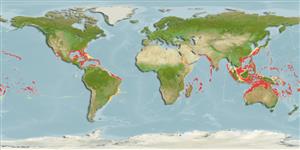Malacostraca |
Stomatopoda |
Odontodactylidae
Environment: milieu / climate zone / depth range / distribution range
Ecology
Benthic; depth range 0 - 424 m (Ref. 80410), usually 15 - 40 m (Ref. 93242). Tropical
Western Atlantic and Indo-Pacific.
Length at first maturity / Size / Weight / Age
Maturity: Lm ? range ? - ? cm
Minimum depth from Ref. 96667. Occurs on mud to fine to coarse sand (Ref. 80410) and stones (Ref. 3121). Usually found in less than 100 m depths, but occurs generally in 40 to 424 m depths. Juveniles can also be found on surface (Ref. 3121).
Life cycle and mating behavior
Maturity | Reproduction | Spawning | Eggs | Fecundity | Larvae
Some members of the order Stomatopoda pair for life and some come together only to mate. Males produce sperm ducts rather than spermatophores; females can brood a maximum of 50,000 eggs. Life cycle: Eggs hatch to a planktonic zoea which lasts for 3 months.
Ahyong, S.T. 2002 Stomatopoda (Crustacea) from the Marquesas Islands: results of MUSORSTOM 9. Zoosystema 24(2):347-372. (Ref. 3509)
IUCN Red List Status
(Ref. 130435: Version 2025-1)
CITES status (Ref. 108899)
Not Evaluated
Not Evaluated
Threat to humans
Human uses
| FishSource |
Tools
More information
Trophic EcologyFood items (preys)
Diet composition
Food consumption
Predators
Population dynamicsGrowth
Max. ages / sizes
Length-weight rel.
Length-length rel.
Length-frequencies
Mass conversion
Abundance
Life cycleReproductionMaturityFecunditySpawningEggsEgg developmentLarvae PhysiologyOxygen consumption
Human RelatedStamps, coins, misc.
Internet sources
Estimates based on models
Preferred temperature
(Ref.
115969): 15.6 - 27.5, mean 23.3 (based on 764 cells).
Price category
Unknown.
